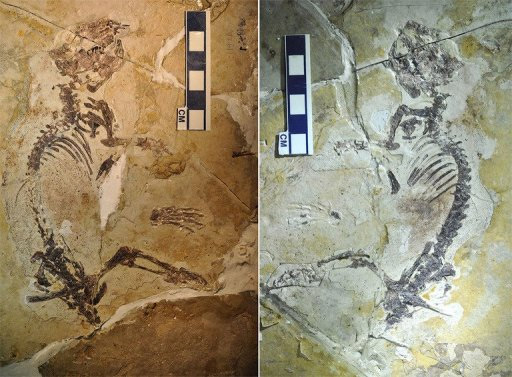Longest mammal lineage fossil unearthed
Xinhua, August 16, 2013
A nearly complete skeleton that belongs to the oldest ancestor of "the most evolutionarily successful and long-lived mammal lineage" on Earth has been unearthed in northeastern China, researchers from China and the United States said Thursday.
Dubbed Rugosodon eurasiaticus, the newly discovered species looked a bit like a small rat or a chipmunk. It lived 160 million years ago and was an early member of the group of mammals known as multituberculates, which flourished across the planet from about 170 million to 35 million years ago.

A fossil of Rugosodon eurasiaticus courtesy of the Univ. of Chicago and the Chinese Academy of Geological Sciences [AAAS/AFP/File, Zhe-Xi Luo/Chongxi Yuan]
"The new mammal is called Rugosodon after the rugose teeth ornamented by numerous tiny ridges and grooves and pits, indicating that it was an omnivore that fed on leaves and seeds of ferns and gymnosperm plants, plus worms and insects," an international team of scientists from Chinese Academy of Geological Sciences, Beijing Museum of Natural History and the University of Chicago said in a statement.
The researchers described in the U.S. journal Science Rugosodon's ankle bones as being "surprisingly mobile and flexible," a feature that suggests Rugosodon was a fast-running and agile mammal.
"The later multituberculates of the Cretaceous era and the Paleocene epoch are extremely functionally diverse: Some could jump, some could burrow, others could climb trees and many more lived on the ground. The tree-climbing multituberculates and the jumping multituberculates had the most interesting ankle bones, capable of 'hyper-back-rotation' of the hind feet," said ZheXi Luo, professor at the University of Chicago and co-author of the study. "What is surprising about this discovery is that these ankle features were already present in Rugosodon."
The researchers also said Rugosodon was a nocturnal mammal and lived in a temperate climate in lakeshores of what is now known as Jianchang County of Liaoning province in northeastern China. At that time, the creature shared the land with the feathered dinosaur Anchiornis, the pterosaur Darwinipterus, and abundant arthropods, several other mammals.
The discovery of Rugosodon extends the distribution of certain multituberculates from Europe to Asia during the Late Jurassic period, the researchers said.
"This new fossil from eastern China is very similar to the Late Jurassic fossil teeth of multituberculates from Portugal in western Europe," explained Luo. "This suggests that Rugosodon and its closely related multituberculates had a broad paleogreographic distribution and dispersals back-and-forth across the entire Eurasian continent."
Multituberculates arose in the Jurassic period and went extinct in the Oligocene epoch, occupying a diverse range of habitats for more than 100 million years before they were out-competed by more modern rodents.
Scientists believed that by the end of their run on the planet, multituberculates had evolved complex teeth that allowed them to enjoy vegetarian diets and unique locomotive skills that enabled them to traverse treetops. Both adaptations helped them thrive in the shadows of dinosaurs and survive through their mass extinction 65 million years ago. They became the most abundant mammals of the Mesozoic Era and constitute almost half of all mammal species that lived in the Jurassic and Cretaceous.
